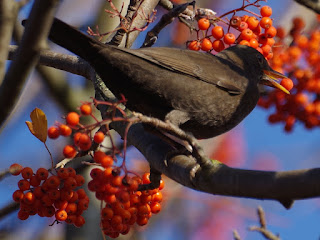Another picture from yesterday, a splendid shot by Tom of one of the Little Grebes on the Round Pond. They weren't there today, and have probably flown back to the Long Water where they are quite hard to find.
Back to today: two Great Crested Grebes chased each other up the Serpentine.
A Cormorant washing under a post at the island ...
... decided to get on to the post to dry. It approached, displacing a Common Gull ...
... heaved itself on to the chain ...
... and from there jumped on to the post.
Often the Black Swan seems to be getting on peacefully with the dominant Mute Swan family at the Vista ...
... and then the male Mute Swan remembers himself and chases her off. She returns and gets chased off over and over again. There is some element of a game in this.
A young Mute Swan swam up and down the fountain pool in the Italian Garden, looking as if it were trapped. But it can get out and return to the lake when it likes, and has already done so several times.
An adult swan preened on the foot-high stone kerb of another pool. I have never seen how they manage to climb on to it from the water. I don't think they use the duckboards, which look too narrow for their ponderous gait.
A very large flock of Egyptian Geese grazing beside the Serpentine -- I counted 65. There are a few Greylags here as well.
The Bar-Headed--Greylag hybrid goose was on the Round Pond with a Canada--Greylag hybrid.
A Carrion Crow emerged from the Lido restaurant terrace with the wrapper of a portion of butter, something to be pecked and licked until the last trace of butter has been eaten.
A Jay gave me a look that means 'Will you put that camera down and give me a peanut!'
Half a dozen Blackbirds were feeding in the rowan tree on Buck Hill.
A Chaffinch picked up spilt birdseed from the feeder in the Rose Garden.














How is the feeder you put up coming along, by the way?
ReplyDeleteI meant to ask about the young Grebe from yesterday's post. Does it have a good chance of making it through the winter? I hope so.
The feeder is quite successful. In its rather shady spot, the tits and other small birds have found it, but the parakeets and rats haven't, It is supposed to be squirrel proof, but Fort Knox isn't squirrel proof.
DeleteThe young grebe should be able to fly in early January. We don't usually get serious ice before then. The main danger to young grebes is not learning to fish well enough to cope with an only moderately well stocked lake.
Excellent record with the Black-necked Grebe. Normally Staines Reservoir is the main place I see them around London.
ReplyDeleteAccording to a rather vague account in Andrew Self's The Birds of London, it's the first Black-Necked Grebe seen in the park since around 1930. The first record from Staines Reservoir was in 1907.
DeleteI did see a young swan get out of the Italian gardens pond - with an angry adult behind it, the momentum plus spread wings enabled it to get a foot on the edging stone and vault out.
ReplyDeleteThanks, interesting. They must have to take a run even when they aren't being chased.
Delete